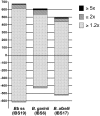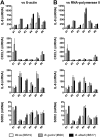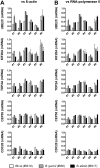Homogeneous Inflammatory Gene Profiles Induced in Human Dermal Fibroblasts in Response to the Three Main Species of Borrelia burgdorferi sensu lato
- PMID: 27706261
- PMCID: PMC5051687
- DOI: 10.1371/journal.pone.0164117
Homogeneous Inflammatory Gene Profiles Induced in Human Dermal Fibroblasts in Response to the Three Main Species of Borrelia burgdorferi sensu lato
Abstract
In Lyme borreliosis, the skin is the key site for bacterial inoculation by the infected tick and for cutaneous manifestations. We previously showed that different strains of Borrelia burgdorferi sensu stricto isolated from tick and from different clinical stages of the Lyme borreliosis (erythema migrans, and acrodermatitis chronica atrophicans) elicited a very similar transcriptional response in normal human dermal fibroblasts. In this study, using whole transcriptome microarray chips, we aimed to compare the transcriptional response of normal human dermal fibroblasts stimulated by 3 Borrelia burgdorferi sensu lato strains belonging to 3 main pathogenic species (B. afzelii, B. garinii and B. burgdorferi sensu stricto) in order to determine whether "species-related" inflammatory pathways could be identified. The three Borrelia strains tested exhibited similar transcriptional profiles, and no species-specific fingerprint of transcriptional changes in fibroblasts was observed. Conversely, a common core of chemokines/cytokines (CCL2, CXCL1, CXCL2, CXCL6, CXCL10, IL-6, IL-8) and interferon-related genes was stimulated by all the 3 strains. Dermal fibroblasts appear to play a key role in the cutaneous infection with Borrelia, inducing a homogeneous inflammatory response, whichever Borrelia species was involved.
Conflict of interest statement
The authors have declared that no competing interests exist.
Figures






Similar articles
-
Microarray analyses of inflammation response of human dermal fibroblasts to different strains of Borrelia burgdorferi sensu stricto.PLoS One. 2012;7(6):e40046. doi: 10.1371/journal.pone.0040046. Epub 2012 Jun 29. PLoS One. 2012. PMID: 22768217 Free PMC article.
-
Identification of three species of Borrelia burgdorferi sensu lato (B. burgdorferi sensu stricto, B. garinii, and B. afzelii) among isolates from acrodermatitis chronica atrophicans lesions.J Invest Dermatol. 1998 Mar;110(3):211-4. doi: 10.1046/j.1523-1747.1998.00130.x. J Invest Dermatol. 1998. PMID: 9506437
-
Expression Profiles of Toll-Like Receptors in the Differentiation of an Infection with Borrelia burgdorferi Sensu Lato Spirochetes.Arch Immunol Ther Exp (Warsz). 2017 Apr;65(2):175-182. doi: 10.1007/s00005-016-0416-8. Epub 2016 Sep 7. Arch Immunol Ther Exp (Warsz). 2017. PMID: 27604757
-
[Heterogeneity of Borrelia burgdorferi: etiopathogenetic relevance and clinical implications].Z Rheumatol. 2003 Apr;62(2):148-54. doi: 10.1007/s00393-003-0428-8. Z Rheumatol. 2003. PMID: 12721702 Review. German.
-
Lyme borreliosis.Lancet Infect Dis. 2003 Aug;3(8):489-500. doi: 10.1016/s1473-3099(03)00722-9. Lancet Infect Dis. 2003. PMID: 12901891 Review.
Cited by
-
Challenge of Bovine Foot Skin Fibroblasts With Digital Dermatitis Treponemes Identifies Distinct Pathogenic Mechanisms.Front Cell Infect Microbiol. 2021 Jan 8;10:538591. doi: 10.3389/fcimb.2020.538591. eCollection 2020. Front Cell Infect Microbiol. 2021. PMID: 33489929 Free PMC article.
-
Effects of golden tomato extract on skin appearance-outlook into gene expression in cultured dermal fibroblasts and on trans-epidermal water loss and skin barrier in human subjects.J Cosmet Dermatol. 2022 Jul;21(7):3022-3030. doi: 10.1111/jocd.14527. Epub 2021 Oct 20. J Cosmet Dermatol. 2022. PMID: 34668310 Free PMC article.
-
Borrelia burgdorferi Engages Mammalian Type I IFN Responses via the cGAS-STING Pathway.J Immunol. 2023 Jun 1;210(11):1761-1770. doi: 10.4049/jimmunol.2200354. J Immunol. 2023. PMID: 37067290 Free PMC article.
-
Transcriptome Assessment of Erythema Migrans Skin Lesions in Patients With Early Lyme Disease Reveals Predominant Interferon Signaling.J Infect Dis. 2017 Dec 27;217(1):158-167. doi: 10.1093/infdis/jix563. J Infect Dis. 2017. PMID: 29099929 Free PMC article.
-
Single cell immunophenotyping identifies CD8+ GZMK+ IFNG+ T cells as a key immune population in cutaneous Lyme disease.bioRxiv [Preprint]. 2025 Jun 12:2025.06.09.658661. doi: 10.1101/2025.06.09.658661. bioRxiv. 2025. PMID: 40661371 Free PMC article. Preprint.
References
-
- Rizzoli A, Hauffe H, Carpi G, Vourc HG, Neteler M, Rosa R. Lyme borreliosis in Europe. Euro Surveill. 2011;16(27). Epub 2011/07/29. . - PubMed
Publication types
MeSH terms
Substances
LinkOut - more resources
Full Text Sources
Other Literature Sources
Medical
Molecular Biology Databases

